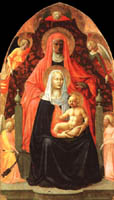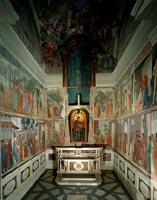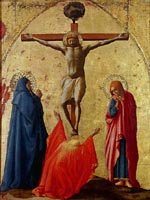 Tommaso of ser Giovanni Cassai, known as Masaccio, was born on 21st December 1401 in San Giovanni Valdarno (Arezzo).
Tommaso of ser Giovanni Cassai, known as Masaccio, was born on 21st December 1401 in San Giovanni Valdarno (Arezzo).
His family moved to Florence and in 1422 he joined the Guild of doctors and apothecaries. Most of the artist’s work was executed in this city but little is known about his training. He is supposed to have been a pupil of Masolino da Panicale but today this seems very unlikely - Masolino was influenced by young Masaccio andnot the other way round.
The painting Sant'Anna Metterza was the beginning of a collaboration between the two painters. The altar piece of the church of Sant'Ambrogio in Florence was painted in about 1424 or 1425 and is now in the Uffizi Gallery.
Critics believe Masolino painted Anne and the angels, with the exception perhaps of the central one in the upper part of the painting and the one holding a curtain on the right. These angels, as well as the Virgin and the Child, were painted by Masaccio. In these figures Masaccio’s artistic style is evident: the bodies of the characters are firmly set in a real setting created by the volume of the bodies themselves. Masolino was influenced by the innovative style of Masaccio’s art, which differed from that of the artists before him; he tried to use the principles of Masaccio’s art but achieved lower quality results.
The two men however worked very well together and Felice Brancacci commissioned the painting of the family chapel in the Chiesa  del Carmine in Florence.
del Carmine in Florence.
The frescos, which depict Stories of the Life of St Peter, as well as some stories from the Book of Genesis, were started in 1424. The two painters divided out the work and painted separately so that their two styles would not clash. Masolino left in 1425; by then the vault was finished (with the symbols of the Evangelists, the end walls with Pentiment of St Peter, Pasce agnos, pasce oves meas, the left and right lunettes showing the Calling and the Shipwreck. These parts unfortunately were destroyed by a fire in the church in 1771). Other fully completed pictures were the Ancestors in Eden, Temptation, Healing of the Lame Man and Resurrection of Tabia by Masolino and the Baptism of the neophytes by Masaccio.
Other paintings are: St Peter’s Sermon (Masolino) and Tribute and the Banishment of Adam and Eve from Eden (Masaccio). From 1425 Masaccio continued working on his own on the lower parts of the chapel. He painted St Peter healing with his shadow, Distribution of alms and death of Ananias, as well as part of the Resurrection of the son of Teophilus and St Peter in cattedra, which was finished at the end of 1426, when Masaccio left (the chapel was finished by Filippino Lippi).
The notary Giuliano del Colino degli Scarsi commissioned a Polyptich for the altar of the family chapel in the Chiesa del Carmine in Pisa. The 25 panels of this work were, during the years that followed, divided between a number of museums. Among these are the  central panel showing the Madonna on a throne with Child and four angels (London National Gallery), where the volumetric definition of the characters bodies and the chairoscuro of clothes and drapings define a life-like setting (like the altar piece of Sant'Anna Metterza); the Child is depicted as he is about to eat a grape – the painters before Masaccio would never have painted the Child performing such a worldy act.
central panel showing the Madonna on a throne with Child and four angels (London National Gallery), where the volumetric definition of the characters bodies and the chairoscuro of clothes and drapings define a life-like setting (like the altar piece of Sant'Anna Metterza); the Child is depicted as he is about to eat a grape – the painters before Masaccio would never have painted the Child performing such a worldy act.
The Crucifixion is part of the Polyptich,now in the National Museum of Capodimonte of Naples. In this painting – like the previous one – there is a worldly touch to the holy event: Christ’s head is sunk between his shoulders, to show the effect of death on a human body. The background is golden and does not, as such, allow any depth, yet the illusion of depth is achieved by painting Magdalene with her back to the observer. Magdalene’s pain is obvious, even if the observer cannot see her face. Masaccio’s last work was Trinity for the basilica of Santa Maria Novella in Florence. The scenes take place on three distinct levels: on the lower level there is a skeleton on a coffin (representing the transitory nature of worldly objects), on the second level the people commissioning the painting are shown kneeling in the chapel (with its complex architecture). The highest level shows the Virgin, St John and Christ on the Cross held by God.
Masaccio died young (he was 27) in Rome at the end of 1428; he was apparently poisoned by a rival.
Leonardo da Vinci, Codice atlantico
Tommaso fiorentino, scognominato Masaccio, mostrò con opera perfetta come quelli che pigliavano per altore altro che la natura s'affaticavano invano.
Vasari, Le vite de' più eccellenti pittori, scultori et architetti
E se bene Paolo Uccello vi si era messo et aveva fatto qualche cosa, agevolando in parte questa difficultà, Masaccio nondimeno, variando in molti modi, fece molto meglio gli scorti, e per ogni sorte di veduta, che niun altroch einsino allora fusse stato.E dipinse le cose sue con buona unionee morbidezza, accompagnando con le incaranzioni delle teste e dei nudi i colori de' panni, i quali si delettò di farecon poche pieghe e facili, come fa il vivo e il naturale....
Fu persona astrattissima e molto a cso, come quello che avendo fissotutto l'animo e la volontà alle cose dell'arte sola, si curava poco di se e manco di altrui. E perchè è non volle pensar già mai in maniera alcuna alle cure o cose del mondo, e non che altro, al vestire stesso, non costumando riscuotere i denari dà suoi debitori, se non quando era bisogno estremo, per Tommaso , che era il suo nome, fu da tutti detto Masaccio. Non già perchè e' fusse vizioso essendoeglila ontà naturale, maper l atrascurataggine, con la quale niente dimanco era egli tanto amorevole nel fare altrui servizio e piacere, che più oltre può bramarsi.
Stendhal, Storia della pittura in Italia
Poichè l'antichità non ha lasciato nulla, quanto a chiaroscuro, colorito, prospettiva ed espressione, Masaccio, piuttosto che il rinnovatore, è il creatore della pittura.